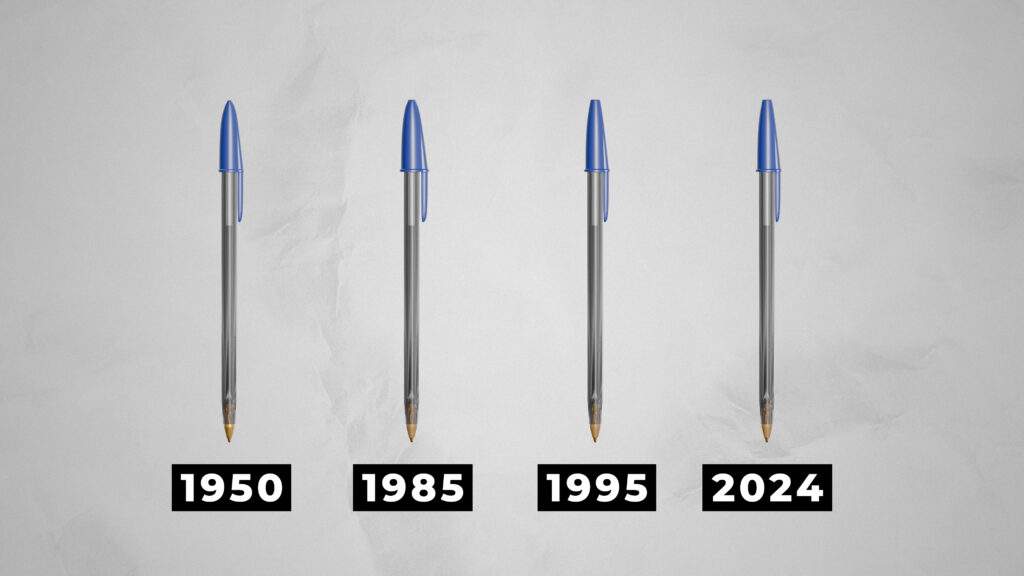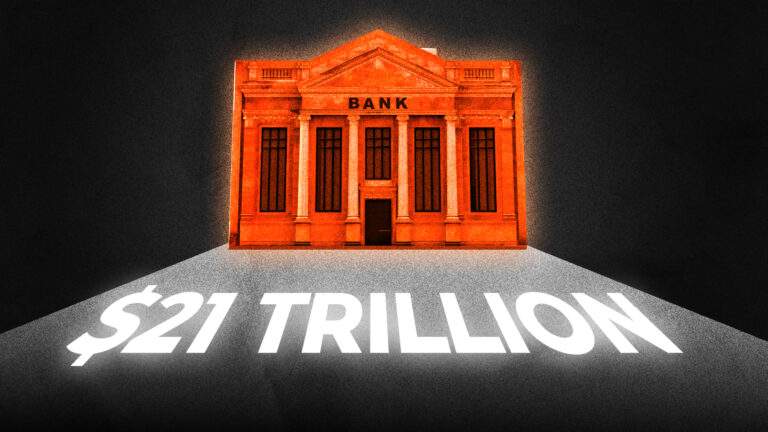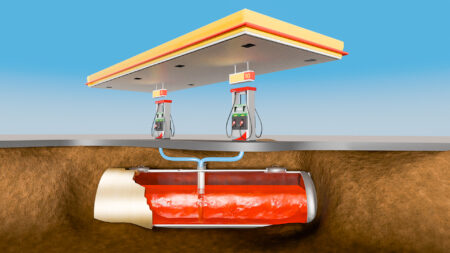This is the BIC Cristal, possibly the most successful product ever made. No matter where you are in the world, you’ll find this pen in homes, offices, schools and pretty much everywhere else. This iconic design has reached every corner of the Earth – and at some point in your life, you’ve almost certainly used this pen.
Since it’s release in 1950, more than 100 billion of these pens have been sold worldwide, blowing the next best-selling products out of the water. Amazingly, the design has remained basically unchanged for over 70 years – and it still continues to dominate the world, with 14 million being sold every day.

The impact this pen had on the world was monumental – pen prices dropped and literacy rates shot up. But what made this pen so successful?
We’re going to tell the incredible story behind this pen, and how its clever use of physics made it the most perfect design. But to really understand how revolutionary this pen was, we need to go back in time.
When pens were bad
In the past, pens were expensive and difficult to use. Traditional quills were messy and had to be constantly dipped in ink. Because of this, writing was seen as more of an art form, limited to those that could use a pen. Then, the fountain pen was invented, which had a metallic nib and could store the ink inside the pen’s reservoir.

Although this was an improvement, the nib was scratchy and couldn’t control the flow of ink – causing sudden blobs to leak out onto the paper. On top of this, they were still super expensive, costing around 150 dollars in today’s money. At the time, only around 20 percent of the world could read and write, and this wasn’t making it any easier.
The ball-point pen
But at the end of the 19th century, a breakthrough was made. American inventor John Loud came up with a mechanism that fed the ink onto the page using a small ball instead of a thin nib. This would in theory spread the ink more evenly and stop it from blotching. He had just invented the ball-point pen. While his design worked well on tougher surfaces like leather and wood, it was too rough on paper – and so his pen never sold. But crucially, his design planted the tiny seed that would lead to BIC’s success.

Problems with the ball-point pen
Decades went by and many new designs were made, but none of them could master the ball-point pen. If the ball was too tight in its socket, the ink would clog up and it wouldn’t reach the paper. If it was too loose, the ink would leak out and smear all over the page. Getting this right was extremely difficult, since the tiny ball was difficult to make with any kind of accuracy. Then came Lazlo Biro, a man with a name you might recognize. He realized that the solution was in the ink.
Most pens at the time used thin water-based ink, which was leaky, slow drying and would seep through the fibers of the paper. It also relied on gravity to feed the ink onto the ball, which depending on the angle of the pen, gave really poor results.
Experimenting with pen ink
He started experimenting with oil-based inks, which were thicker, dried almost instantly and sat on top of the paper, instead of seeping through. This turned out to be a stroke of genius – and it unlocked a unique physical effect that caused the ink to be mysteriously pulled onto the ball, without gravity or any external forces.

This is called Capillary action and it’s what allows water to climb tree roots and nutrients to flow around our body. We can see this effect in action by placing a thin tube into some water and watching it climb. But what’s happening here?
Capillary action
The attraction between the liquid and the walls of the tube is stronger than the attraction that binds the liquid particles together. And so the particles at the top get pulled up by the side of the tube, until the weight of the water eventually cancels out the force.

In Biro’s pen, this effect was happening upside down. The ink was being pulled through by the ultra thin walls of the tip and onto the ball, ensuring that it was constantly covered in ink.
The Biro pen
In order to master the ball-point pen, Biro came up with a new design that would pull the ink onto the ball without gravity or moving parts, producing a consistent and smooth line on the page. Biro mastered his design, and his pen became a hit in South America. But there was still one huge problem. The cheapest pen he offered cost an incredible 190 dollars in today’s money. And so although the design was great, he never achieved mass market success. At this point, literacy rates had only hit around 33%, and pens remained a luxury item.
Making the BIC Cristal
But just a few years later, French manufacturer Marcel Bich discovered Biro’s pen, and saw a huge opportunity. He bought the patents for 2 million dollars and began designing a new and improved version that could be mass-produced for a much cheaper price. With the help of state-of-the-art Swiss watchmaking machines, he developed a method for mass producing tiny stainless-steel balls, to within a fraction of a millimeter. Instead of using metal for the rest of the pen, he bought machines that could mold plastic, something that had only been around for a few years at this point. This was the end result.
The BIC Cristal’s design
Although it may just look like a pen, it’s hard to overstate just how perfect this design turned out to be. There were no moving parts, springs or complex materials, yet every element had multiple purposes. Let’s take a closer look. The pen had a hexagonal barrel, like a pencil, which stopped it from rolling off tables and made it easier to grip. It was made from polystyrene, which was strong, cheap and transparent, allowing the ink level to be seen at all times.
There was a tiny hole on the barrel, which allowed air to enter and replace ink as it left the pen. If it didn’t have this hole, the pressure difference at higher altitudes would cause the ink to be pushed out the pen. And so the hole was also there to maintain the outside air pressure. The ink inside the cartridge was a special recipe that maximized the capillary effect whilst still producing a good quality line. Each pen had enough ink to produce about 3 kilometers of line.

The ink flowed into the tip of the pen, which contained the stainless steel ball. The ball was machined so accurately and could move just enough to spin and deposit ink onto the page. When the pen wasn’t being used, the ball would create a seal, stopping ink from leaking out the bottom. If the pen was turned upside down, the capillary action and the surface tension of the ink would stop it from falling out the back of the pen.
The lid, which also doubled as a clip, was made from polypropylene, which absorbed impacts and stopped the pen from cracking. The pen was so perfectly simple and solved every problem that plagued previous pens. It was reliable, comfortable to use and produced a smooth and consistent line. Most of all, it was cheap, hitting the market in 1950 at just 2 dollars – much cheaper than the 190 dollar alternatives.
Worldwide success
It was an instant success, selling around 10,000 units daily in France during its first year. Marcel realized how English speaking countries were pronouncing his name, so he dropped the ‘H’ and the Bic name was born. Marcel understood the importance of the economies of scale – and he quickly expanded to other continents, setting up factories all over the world.

By 1953, he was already selling 40 million pens per year, and the BIC Cristal took over the world. Now, anyone in the world that wanted to write or draw could do so, and it was easy. Literacy rates rose all around the world, and the demand for a good pen went through the roof. The world had secretly been begging for this product, and it came at the perfect time. Over the next 50 years, 100 billion of these pens were sold and literacy rates went from 35% to almost 90%.
It’s almost impossible to imagine life without this pen – and the fact that its design has remained almost exactly the same since day 1 shows just how perfect it was.
References
- https://www.cascade.app/studies/bic-strategy-study
- https://steemit.com/history/@aakashsinha/bic-the-company-behind-the-pen
- https://u.osu.edu/bicpens/03-manufacturing/
- https://newatlas.com/technology/biro-pen-changed-writing-game/
- https://www.dayspringpens.com/blogs/the-jotted-line/who-invented-the-ballpoint-pen-history
- https://penlimitedelkos.medium.com/the-science-behind-smooth-writing-how-ballpoint-pens-work-f63fa5d0ac12
- https://www.writepads.com/blogs/news/the-mightiest-pen-a-brief-history-of-the-ballpoint-pen














How to make videos like you in blender? Any recommended tutorials? Plz
I dn’t have any specific tutorials. It’s best to think about what you want to make then try doing it yourself, then search for specific tutorials along the way. There are tutorials for basically everything!
Is there any way you would ever make a print/poster for the cristal pen? I’d love to buy something like that. Genius product.
world literacy rates rose to 87% in 2022 -up 12% from 1820. Where does the “35% to 90% in fifty years” come from? A particular country or region biased statistic? Otherwise, great article!